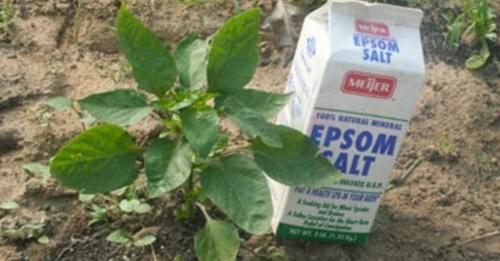Epsom salt, commonly used in baths for sore muscles, has proven to be more than basic. Also known as magnesium sulfate, it contains the minerals magnesium and sulfur, both of which are beneficial to plants.
In case you didn’t know, Epsom salt is considered many gardeners’ best friend. If you want to have a green thumb or simply use fewer chemicals outdoors, find out how to use Epsom salt outdoors.
Pest Control
Epsom salt in your flower beds or garden can help keep pests like snails, slugs or groundhogs away. Sprinkle it around your plants or make a spray solution with two tablespoons of Epsom salt and a gallon of warm water.
Greener Lawns

Even Bob Vila signed off on this one. For greener grass, spread Epsom salt around your lawn with a seeder or by hand.
Weed killer
Nip weeds in the bud with a few doses of this mixture: 1 gallon white vinegar, 2 cups Epsom salt and ¼ cup dish soap. Spray it directly on the weeds; the dish soap helps it cling while the salt dehydrates the weeds. Extra tip: vinegar with 10% or more acidity works best.
Large yields of peppers and tomatoes

Epsom salt, a favorite of bell pepper and tomato growers, can increase the size, flavor and quantity of plants grown in the garden. When used dry, simply apply it to the base of the plant at a rate of one tablespoon per foot of height and water immediately. Applied every two weeks, this foliar spray recipe will also do the trick: 1 to 2 tablespoons of Epsom salt + 1 gallon of water in a spray bottle.
Sweeter fruit
Home gardeners and small farmers have embraced Epsom salt for brighter, sweeter crops. Cantaloupes benefit from a handful of salt sprinkled into the soil during the final weeks of growth. Peaches, strawberries, watermelons and citrus can also receive a dose in the soil or as a foliar spray every two weeks. Experienced growers report sweeter fruit and greener foliage.
Leaf Conditioner

Notice that your plants’ leaves are curled or yellow? Remedy magnesium deficiency by spraying or sprinkling Epsom salt. Spray the leaves directly with the recipe above or add a handful and sprinkle it into the soil.
Trees
For those who have palm trees in their garden, add 1-2 cups of Epsom salt around the trunks to prevent yellowing and drying out. To get rid of tree stumps, drill holes all around the stump, about 20 cm deep. Fill the holes with Epsom salt and add just enough water to moisten it. Cover the stump with a tarp or soil. This will help dry and rot the stump.
Pinker roses

Gardeners rave about the results of Epsom salt for richly colored roses. Before planting new bushes, soak the roots in ½ cup of Epsom salt dissolved in 1 gallon of water. When they are in bloom, rake 1 tablespoon into the soil at the base and water them, once a month. Use a foliar spray once or twice a month.
Nourish the soil
Epsom salt nourishes the soil with its magnesium and sulfur content. It helps with nutrient supply, chlorophyll production, and many farmers and gardeners consider it an exceptional fertilizer. It is also good for houseplants!
The sprouter

Adding 1-2 tablespoons of Epsom salt to the soil before planting will help with seed germination and transplant shock. Simply add it to the bottom of the hole and cover it with a little soil before planting new seeds or seedlings.
Have you been in the know on Epsom salt gardening tips?
Has it helped your plants?
What other ways do you use Epsom salt?
Sources:
Harvest to Table
Garden.org
Epsom Salt Council










